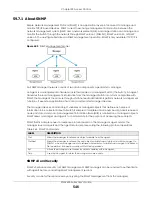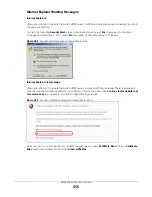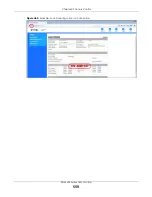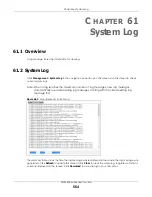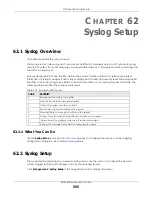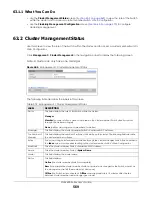
Chapter 59 Access Control
XGS4600 Series User’s Guide
554
59.7.2.3 Requirements for Using SSH
You must install an SSH client program on a client computer (Windows or Linux operating system) that is
used to connect to the Switch over SSH.
59.7.3 Introduction to HTTPS
HTTPS (HyperText Transfer Protocol over Secure Socket Layer, or HTTP over SSL) is a web protocol that
encrypts and decrypts web pages. Secure Socket Layer (SSL) is an application-level protocol that
enables secure transactions of data by ensuring confidentiality (an unauthorized party cannot read the
transferred data), authentication (one party can identify the other party) and data integrity (you know if
data has been changed).
It relies upon certificates, public keys, and private keys.
HTTPS on the Switch is used so that you may securely access the Switch using the Web Configurator. The
SSL protocol specifies that the SSL server (the Switch) must always authenticate itself to the SSL client (the
computer which requests the HTTPS connection with the Switch), whereas the SSL client only should
authenticate itself when the SSL server requires it to do so. Authenticating client certificates is optional
and if selected means the SSL-client must send the Switch a certificate. You must apply for a certificate
for the browser from a Certificate Authority (CA) that is a trusted CA on the Switch.
Please refer to the following figure.
1
HTTPS connection requests from an SSL-aware web browser go to port 443 (by default) on the Switch’s
WS (web server).
2
HTTP connection requests from a web browser go to port 80 (by default) on the Switch’s WS (web
server).
Figure 452
HTTPS Implementation
Note: If you disable HTTP in the Service Access Control screen, then the Switch blocks all HTTP
connection attempts.
59.7.3.1 HTTPS Example
If you have not changed the default HTTPS port on the Switch, then in your browser enter “https://Switch
IP Address/” as the web site address where “Switch IP Address” is the IP address or domain name of the
Switch you wish to access.







